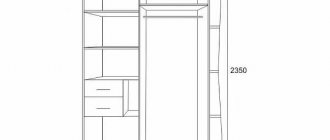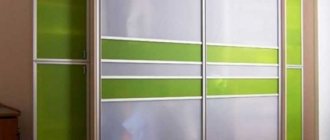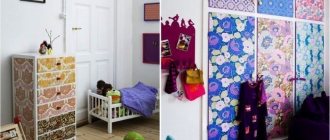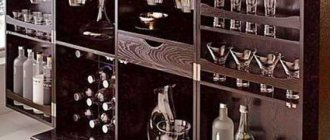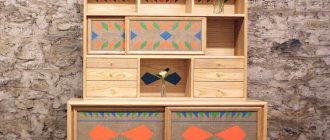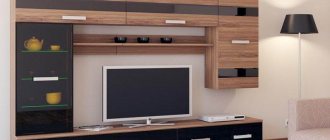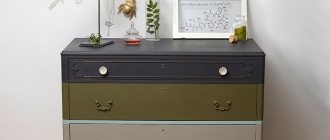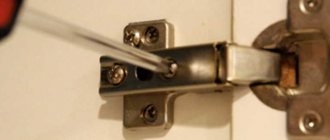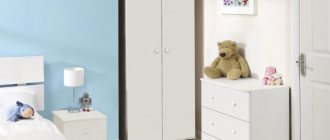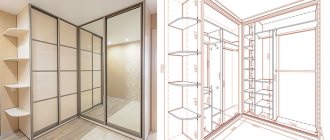To restore an old cabinet, it is not at all necessary to contact specialists. You can update your furniture yourself at home. Before you restore an old cabinet, it must be thoroughly wiped down. There should be no dirt on the surface of the furniture. Then you need to get rid of the top coating. The next stage is sealing cracks and chips. Only after this do they move on to decorating. The restoration is completed by applying a protective composition.
Budget restoration of products
The easiest and most inexpensive way to update a cabinet that has lost its attractiveness is to cover it with wallpaper or photo wallpaper. This decoration is suitable for the restoration of a wardrobe, wardrobe, chest of drawers and bedside tables, which are installed in dry rooms.
The most suitable are non-woven and vinyl wallpapers or photo wallpapers, which are sold in construction stores.
Pasting is performed partially or completely. How to update old furniture:
- The wallpaper used for restoration should differ in pattern from those that cover the walls in the room, but have a common style and color scheme;
- If the walls of the room are covered with light-colored canvases, choose bright wallpaper to update the old cabinet. When the interior has wallpaper with a pattern or design, the furniture is covered with plain wallpaper;
- Internal shelves and external facades can be decorated in different combinations. Additionally, new fittings are used. It is convenient to decorate furniture with self-adhesive wallpaper;
- To work you will need a brush, PVA glue, a construction knife, and decorative wallpaper. It is easier to glue paper sheets, but vinyl and non-woven fabrics are more durable;
- The product is measured, the wallpaper is cut into strips of the required length, the glue is evenly distributed over the surface, the wallpaper is glued, and the coating is carefully smoothed.
It is recommended to use wallpaper to treat old cabinets made of natural wood without polished elements or to finish the interior of a cabinet that does not have a varnished coating.
Before wallpapering, degrease the surfaces with alcohol, acetone or gasoline. Self-adhesive is applied to the cabinet elements and smoothed so that air bubbles do not form.
Transformation with film
The advantage of the film is that it is easy to apply and is easy to clean. This is one of the few materials that holds up on old Soviet lacquered cabinets. Their varnish coating is very difficult to remove, which greatly limits decoration options.
It is not necessary to cover the entire closet with some kind of monochromatic film. You can always find options with unusual patterns or ready-made cut out patterns. Again, there is always the option of cutting out a pattern or silhouette yourself. This self-adhesive film can also quickly transform any mirror or glass, and if you are tired of the result, then it is quite possible to peel it off.
Application of three-dimensional drawings
Decorative plaster and stencil painting are an interesting way to restore an old cabinet. This design will elevate the furniture and give the surfaces a voluminous decor.
Suitable for decorating not only wardrobes and chests of drawers, but also for restoring kitchen furniture (sideboard, cupboard).
The paint will reliably protect the products from temperature changes and moisture. For work, use decorative plaster, acrylic paint, varnish, a stencil with the desired pattern, a spatula, masking tape, sandpaper, and brushes. Painting a cabinet with your own hands requires following a precise work algorithm:
- The fittings are removed from the furniture.
- Remove the layer of old coating.
- Treat with sandpaper.
- Cracks and chips are repaired with putty.
- The stencil is secured with masking tape.
- Prepare the plaster according to the instructions.
- Apply the material with a flat spatula.
- The stencil is removed and the pattern is corrected with a knife.
- After drying, the drawing is sanded with sandpaper.
- Paint is applied to the renewed base.
- To consolidate the effect, coat with varnish.
The same method is used to paint an old cabinet using a stencil, but without decorative plaster. Against the background of patterns, fittings painted in gold or silver look impressive.
To obtain a contrasting pattern, the product is coated with white paint. After the layer has dried, attach a stencil and spray it with spray paint (shake first) of the desired shade - the decorative coating is ready, and the furniture takes on an interesting appearance.
To ensure that the paint evenly covers the furniture and does not peel off, cabinets, bedside tables, chests of drawers, and wardrobes are prepared for painting by removing dust, dirt, and greasy stains.
Any shade can be used as a base background, but the design looks most expressive when the stenciled cabinet is painted white.
With a brush in hand
Decorating a cabinet with paints is one of the easiest things to do. Even just a cabinet painted in one color already looks completely different. It is best to use water-based paint or acrylic. Water-based paint is more advantageous for use on large surfaces, for example, for the facade of a cabinet, but acrylic is more convenient for doing “jewelry” work.
A brush and a little inspiration can do incredible things with furniture.
The cabinet doors can be highlighted with a different color outline - and the entire facade will instantly seem three-dimensional. Stripes of different thicknesses or cheerful polka dots look amazing. To do this, you don't need any artistic skills at all. It is enough just to mark the cabinet well so that the pattern is uniform throughout the furniture.
If you have artistic skills, then your closet is incredibly lucky! Imagine your furniture as a canvas and start creating! Floral and plant motifs, fairy-tale and fantasy paintings, entire landscapes or paintings will look interesting. It is best to first make a sketch on paper to see exactly how the cabinet should look, and then transfer all the ideas to the furniture. For detailed drawing you will definitely need acrylic.
Water-based and acrylic paints are practically odorless. So you can paint furniture at home. However, place film or paper under the cabinet so as not to stain the floor. There is no need to coat the finished decor with any varnishes. Both paints are very durable.
What to do if there are a lot of ideas for painting a closet, but the inner artist has escaped somewhere? Then we will decorate any cabinets using a stencil. Such a useful thing can be found in all sorts of art stores or you can make it yourself. To create a stencil yourself, you will need the selected design, a thick but transparent plastic folder, something to write on, and scissors.
Print out the drawing in the required size. If it is very large, then divide it into several sheets. Then place the paper under the folder, draw this pattern on the plastic and cut it out. That's it, you have a stencil. Now you can decorate cabinet doors with the most intricate patterns.
Painting polished furniture
Interior items made from natural wood and coated with a polished layer can be given an unusual look using cabinet paint. An old product, refined in a modern design, will become the central element of the room and give the room a special charm.
How to paint a cabinet or decorate a wardrobe:
- For work use acrylic paint with a matte effect.
- To degrease the base, use acetone or white spirit.
- To apply paint you need brushes, and for decoration you need new pens.
- Old fittings are removed from the cabinet, shelves and drawers are taken out.
- All surfaces are treated with a sanding machine.
- Coarse and fine-grained sandpaper is selected for the tool.
- If there are large chips on the surface, they need to be puttied.
- Treat the furniture with white spirit or acetone and dry it.
- How to paint a cabinet - Apply a thin base coat of paint.
- After drying, rub over with fine-grained paper.
- Remove dust with a dry cloth, apply the next layer and dry.
- Rub again and apply another layer until the desired effect is achieved.
Using this method, you can transform an old polished cabinet into original vintage furniture that will decorate a classic interior. The fittings are screwed into their original places.
For exclusive work, you can use not full painting, but dot painting - a pattern is applied to the furniture facades with a marker and the design is drawn with acrylic paint.
Methods that do not require the use of paints
Using photo wallpaper
Photo wallpaper intended for doors is suitable for finishing a sliding wardrobe. You may have to trim them a little: standard photo wallpaper for doors has a size of 86x220 cm. Using photo wallpaper you can create original images on your wardrobe.
- Before pasting wallpaper, degrease the surface.
- Glue the photo wallpaper using PVA glue. But it is better to glue photo wallpapers with a special self-adhesive back side to varnished surfaces.
For mosaics on doors, it is better to use acrylic or glass mosaics. Ceramic is too heavy and bulky.
- Pre-clean the surface where you are going to glue the mosaic.
- Mark the surface with a pencil to make an even element.
- Attach the mosaic with Moment glue, or better yet, with liquid nails.
Here are some simple and original ways to decorate a closet. Create with pleasure and enjoy what you create!
Updating chipboard cabinets
Furniture made from particle boards loses its attractiveness over time, no matter how carefully it is used. You can return your products to their beautiful appearance and add fresh colors to the interior by painting old chipboard cabinets.
It should be taken into account that chipboard does not absorb paint well, since the furniture is covered with a moisture-repellent laminated layer.
In addition, if the condition of the cabinet fastening elements is unsatisfactory, it is recommended to replace the fittings and further strengthen them. How to paint an old chipboard cabinet:
- All removable elements are removed from the furniture so that an empty frame is left for painting.
- Using coarse sandpaper, remove the layer of old paint (if any) and varnish.
- The surfaces must be rubbed carefully so as not to damage the base. The cabinet is swept with a dry rag to remove dust.
- Corners, edges, joints and protruding elements are treated with fine-grained sandpaper.
- Water-based acrylic paint is a better option than painting chipboard. The color scheme is chosen according to your taste.
- Before painting, a chipboard cabinet must be primed so that the paint is less absorbed into the material.
- The primer is applied in a thin, even layer and the composition is allowed to dry - usually acrylic primers dry in no more than 12 hours.
- Apply several layers of paint with a roller or brush (preferably a brush), each time drying the coating before painting.
- When the furniture is painted to securely fix the coating, after complete drying, the chipboard cabinet is treated with varnish, and the product is assembled using new fittings.
When painting furniture, choose only high-quality tools that do not leave lint on the painted surface. The more layers of paint are applied, the richer the color of the decorative coating will be. You need to repaint with a brush in one direction - from top to bottom, apply the paint with a roller in a cross-shaped motion.
On video: detailed instructions for updating an old chipboard cabinet.
Method number 1. Large vinyl sticker
Vinyl decorative stickers for wardrobes, as a rule, are produced on a single-color German Oracal film, which greatly simplifies color matching. Outwardly, they look like a stylish pattern applied with paint. At the same time, you will be able to care for the cabinet in the usual way. Unless you resort to strong friction. And most importantly, when you get tired of one design on the door of a closet, you can literally remove the sticker in a minute without any traces and apply a new one.
This method is universal and can be used for doors made of any materials. You can safely apply stickers to glass and mirrors of sliding wardrobes. They hold up well and look very impressive. At the same time, you get rid of the obsessive reflection, and fingerprints that constantly appear on the glass surface will no longer be too noticeable.
The procedure for applying a large sticker on the wardrobe door:
- Preparation . Clean the surface from dust, fingerprints and other contaminants;
- Smoothing. Place the sticker on a flat surface and smooth it with a squeegee (smoothing spatula), which our store always sends in the kit;
- Fitting. Attach the drawing to the door and mark the position of the corners with a pencil or erasable felt-tip pen. For accuracy, we recommend sticking the sticker with a backing onto masking tape and seeing from a distance how the drawing will look.
- Removing the substrate and applying . Since the sticker is large, remove the backing directly from the canvas attached to the tape from top to bottom in small pieces. Immediately apply the freed pattern to the surface and smooth it carefully with a squeegee without unnecessary pressure. And so on to the very bottom. At the same time, remove the transparent mounting film from top to bottom. The work should be done slowly and carefully. Carefully smooth out everything, even the smallest bubbles. It is most convenient to apply non-adhesive adhesives to closet doors with two people. If bubbles still remain, pierce them with a needle closer to the edge and remove the air with a squeegee.
- Examination. After removing the backing and mounting film, take the time to carefully look at how each element is stuck. Even for a small flower, all edges should be level on the surface.
This video will show you how to apply large vinyl stickers on surfaces:
Helpful tip: when applying a sticker to a mirror or glass of a wardrobe, spray the surface with water. The sticker will be easier to smooth out.
How to Update Kitchen Cabinets
The kitchen is a wet and frequently used room. The furniture in this room is exposed to temperature, steam, moisture and mechanical influence, so kitchen cabinets are more likely to lose their original appearance than furniture for the living room or bedroom. You can restore an old cabinet in the kitchen by painting or finishing the products with rattan fabric.
What paint to paint? Acrylic moisture-resistant composition or alkyd enamel are suitable. An updated cabinet with a glossy shine looks impressive.
The procedure for painting kitchen cabinets is as follows:
- Preparing furniture - the doors are removed from their hinges, thoroughly cleaned of dirt, degreased, washed with soda to remove all dirt;
- Removing the old coating - all surfaces of the kitchen cabinet are treated first with coarse-grained sandpaper, and then with fine-grained sandpaper, and wiped off dust with a dry cloth;
- An acrylic or alkyd primer is applied with a roller or brush - depending on the chosen paint material. The primer is allowed to dry;
- How to repaint a closet? Apply the first layer of paint thinly using brushes or rollers. After drying, apply a second layer with a paint pad using longitudinal and transverse strokes;
- When the front side is dry, you can paint the edges of the furniture parts and the inside. When working, do not press on the pad to avoid drips;
If the resulting color does not match the desired shade in terms of saturation and brightness, the product is painted again. The use of white color is suitable for any kitchen interior. The furniture is assembled using new fasteners and decorative fittings (handles, rails, moldings).
If, when disassembling the cabinet, you have difficulty unscrewing the fasteners, you can drop a little oil on the screws. You can also lubricate the doors so they don’t squeak.
Dressers, chests of drawers, and bedside tables are painted in the same way, but it is not necessary to use water-repellent paint for them - you can use oil, acrylic and alkyd compositions for interior work.
Recommendations for furniture restoration
To give an old cabinet an unusual look, they use not only painting, but also fabric upholstery, decoupage, vinyl stickers, stained glass film and other decorating techniques. In what cases can they be used to restore an old cabinet with your own hands:
- Closet. It usually has mirrored or glass doors. You can decorate furniture using stained glass film or vinyl stickers. The decor is glued to the doors of the wardrobe.
- Chiffonier. Old wooden furniture made of plywood and fiberboard will be transformed if you use decoupage or artificial aging to update it, decorating the furniture in a retro style.
- Sideboard. An antique china cabinet can be improved by applying decorative plaster techniques or by repainting the furniture completely white using bleaching paste.
- Wardrobe for children's room. A child will like “cheerful”, bright furniture, which is repainted independently using dot painting with children’s scenes.
- Wardrobe in the living room. Furniture decorated with a collage of photographs looks unique. Beautiful photographs are pasted onto the cabinet completely or in some places and covered with colorless varnish.
Using your own imagination and creativity, you can update an old cabinet and make it the highlight of your interior. The furniture will sparkle with new colors and become the central element of the room. The most unusual techniques are used for decoration, the choice of which will satisfy any artistic taste.
Master classes from specialists (2 videos)
New life for old cabinets (33 photos)
Szafa pomalowana na bialo i oklejona powiekszonymi fotografiami. Wykonanie i aranzacja: Malgorzata SzczepanskaMethod No. 2: Decorating wardrobe doors with corner patterns
If you don't want to cover the entire surface of the door, we recommend using vinyl decals with elegant angular patterns. Here you will get additional benefits:
— corner patterns are smaller, so the sticker will cost less;
— small elements are much easier and faster to apply;
— by decorating the corners, you will allow the mirror to serve you as a mirror.
When applying a small vinyl decal, we recommend removing the backing . Place it on a flat surface with the pattern down, pick up one of the corners and carefully remove it at an acute angle. If any element sticks to the backing, return the area to its place, iron it again with a squeegee and try to remove further. The sticker should remain on the transparent film with the adhesive layer facing up.
When applying the sticker, take the upper corners of the mounting film and stick it, smoothing it from top to bottom along the marking lines. It’s good if you have a second person helping you to support the sticker from below so that it doesn’t stick prematurely.
